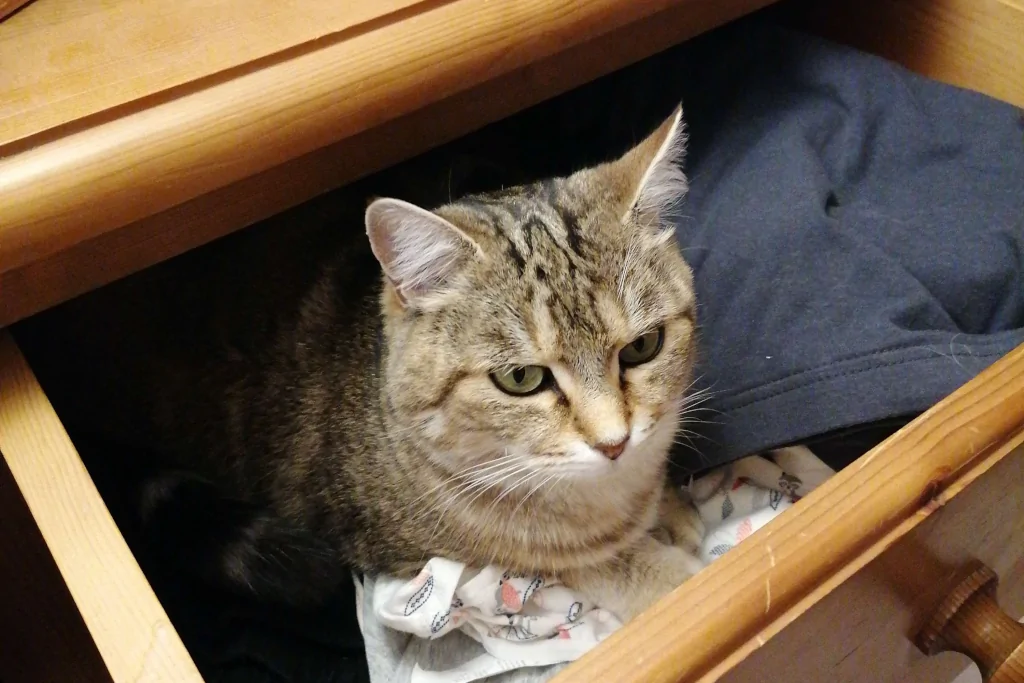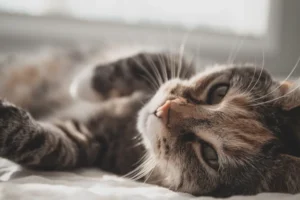Disclosure: We may earn a commission from helpful, relevant links in our content. No cost to you. See our privacy policy.
Cats opening drawers can be both puzzling and frustrating for pet owners. Discovering how to stop this behavior can be the key to a more harmonious household.
Let’s dive into the reasons behind your feline’s fascination with drawers and explore effective solutions to keep them occupied and safe.

Why Are Cats Drawn to Drawers?
First, let’s understand why cats are so drawn to drawers.
Cats are curious creatures by nature, and drawers provide an irresistible combination of mystery and hiding spots.
Small, enclosed spaces give cats a sense of security and comfort, making drawers the perfect place to explore, nap, or even stash their “treasures.”
Additionally, the act of opening drawers can be a stimulating challenge for intelligent cats, engaging their problem-solving skills and providing them with a sense of accomplishment.
Child-Proof Locks (And Other Deterrents)
One of the most effective ways to prevent your cat from opening drawers is by using child-proof locks and other deterrents. In this section, we’ll discuss various methods to keep your cat from accessing those enticing drawers.
- Child-Proof Locks. These locks are designed to keep curious toddlers out of drawers and cabinets, but they work just as well for cats. There are various types of child-proof locks, such as magnetic locks, adhesive locks, and spring-loaded locks. Choose one that works best for your furniture and install them on the drawers you want to keep your cat out of.
- Double-Sided Tape. Cats dislike the feeling of sticky surfaces on their paws. Applying double-sided tape to the edges of the drawer can discourage your cat from trying to open it. Make sure to use a tape that won’t damage your furniture, such as one of these.
- Furniture Blockers. Placing a heavy object, such as a book or decorative item, in front of the drawer can make it difficult for your cat to access. Simple. This method works best if you only need to block a few drawers and have the space to accommodate the blockers.
- Drawer Latches. Similar to child-proof locks, drawer latches can be installed on the inside of your drawers to prevent them from being easily pulled open. Some latches require drilling and screws, while others can be installed using adhesive strips. Choose the ones best for you.
- Motion-Activated Deterrents. Devices like motion-activated air sprayers or ultrasonic sound emitters can startle your cat and discourage them from approaching the drawers. Place the deterrent near the drawers you want to protect, and make sure it’s set to a level that won’t harm your cat.
- Door Knob Covers. If your cat is opening cabinet doors rather than drawers, door knob covers can be a simple solution. These covers make it difficult for your cat to grip and turn the knob, effectively keeping them out of the cabinet. This double-button knob is a great choice.
By implementing one or more of these deterrents, you can create a cat-proof space that keeps your belongings safe and your cat out of trouble. Remember to always monitor your cat’s behavior to ensure their safety and well-being while using these methods.

Creating Cat-Friendly Spaces for Exploration
To keep your cat entertained and satisfied without resorting to opening drawers, it’s essential to create cat-friendly spaces for exploration.
By offering alternatives, you can encourage your cat to engage in appropriate activities instead of targeting your furniture. Here are some ideas to create a stimulating environment for your cat:
- Cat Trees and Shelves. These vertical spaces give cats the opportunity to climb, perch, and observe their surroundings from a high vantage point. Place cat trees and cat shelves near windows to give your cat a view of the outdoors.
- Hideaways and Tunnels. Cats love to hide and explore small, enclosed spaces. Provide your cat with hideaway spots like cardboard boxes, cat tents, or even commercially available cat tunnels. These spots can serve as a safe haven and a fun place to play.
- Interactive Toys. Offer your cat a variety of toys that stimulate their natural hunting instincts. Puzzle toys, treat dispensers, and battery-operated toys that mimic prey can keep your cat engaged and mentally stimulated.
- Scratching Posts. Provide scratching posts and pads to satisfy your cat’s instinct to scratch and mark their territory. Place them in areas where your cat spends the most time to encourage their use.
Redirecting Your Cat’s Curiosity
Redirecting your cat’s curiosity away from drawers and towards appropriate activities can help stop their drawer-opening behavior. Here are some strategies to guide your cat towards better habits:
Positive Reinforcement. Reward your cat with treats, praise, or attention when they engage in appropriate behaviors, such as playing with toys or using scratching posts. This helps to reinforce the desired behavior and make it more appealing.
Scheduled Playtime. Set aside time each day for interactive play with your cat. Use toys that mimic birds, mice, or other prey to engage their hunting instincts. This can help channel your cat’s energy into appropriate activities and reduce their interest in drawers.
Environmental Enrichment. Make sure your cat’s environment is stimulating and enriched. Offer multiple sources of entertainment, such as bird feeders outside windows, fish tanks, or even cat videos on a tablet or TV screen.
Training. Teaching your cat to come to you, or some basic commands, such as “leave it” or “off,” can help redirect their curiosity away from drawers.
Use positive reinforcement and patience to gradually train your cat to respond to these commands and deter unwanted behaviors.
By providing your cat with engaging alternatives and redirecting their curiosity, you can effectively stop their drawer-opening behavior and create a happier, more harmonious home for both you and your feline friend.
Balancing Safety and Feline Fun
Regularly inspect cat toys and furniture for wear and tear, and replace any damaged items to prevent potential accidents.
Make sure that any small objects or choking hazards are kept out of your cat’s reach, and secure any unstable furniture to prevent tipping.
Lastly, avoid using string or yarn for play, as they can pose a risk of ingestion and intestinal blockages.
Our feline friends have their own unique personalities and needs. By being proactive and taking the time to understand and address their curiosity, you can create a safe and enjoyable environment for your cat while also preserving your belongings.
Happy, engaged cats make for content and worry-free cat owners.
FAQs
Why do cats like to sleep in drawers?
Cats like to sleep in drawers because they provide a cozy, enclosed space that offers a sense of security and warmth.
How can I train my cat not to open drawers?
To train your cat not to open drawers, use positive reinforcement for appropriate behaviors, provide alternative stimulation like toys and vertical spaces, and consider using child-proof locks or other deterrents to prevent access.
Are certain cat breeds more likely to open drawers?
Certain breeds, such as Siamese, Bengal, or Maine Coon cats, may be more prone to opening drawers due to their increased curiosity and intelligence.
Can opening drawers pose any risks to my cat?
Opening drawers can pose risks to your cat, including potential injury from sharp objects, exposure to toxic substances, or even getting trapped in a drawer.
Alex, a passionate animal lover, has experience in training and understanding animal behavior. As a proud pet parent to two dogs and three cats, he founded AnimalReport.net to share insights from animal experts and expand his knowledge of the animal kingdom.




